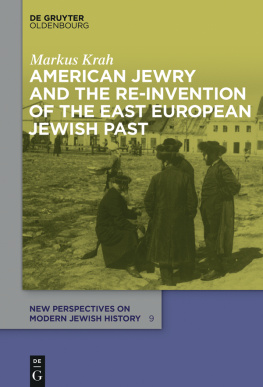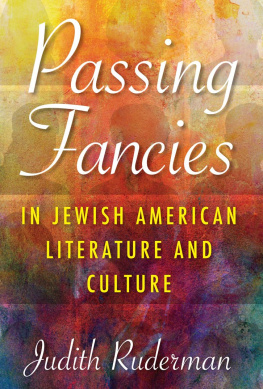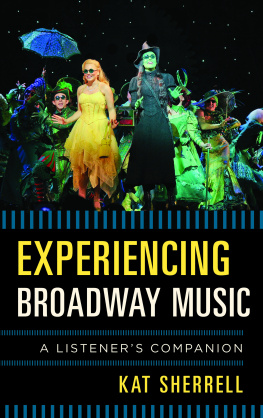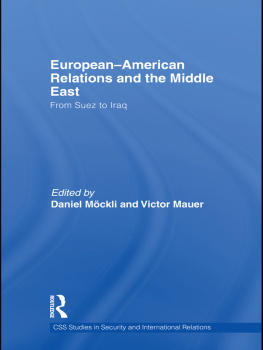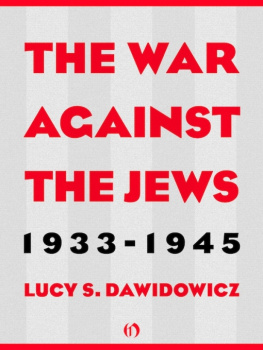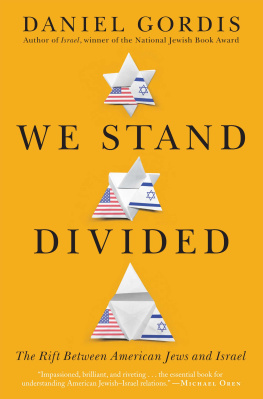Contents
Guide

Markus Krah
American Jewry and the Re-Invention of the East European Jewish Past
New Perspectives on Modern Jewish History

Edited by Cornelia Wilhelm
Volume 9

ISBN 978-3-11-049992-6
e-ISBN (PDF) 978-3-11-049943-8
e-ISBN (EPUB) 978-3-11-049714-4
Library of Congress Cataloging-in-Publication Data
A CIP catalog record for this book has been applied for at the Library of Congress.
Bibliographic information published by the Deutsche Nationalbibliothek
The Deutsche Nationalbibliothek lists this publication in the Deutsche Nationalbibliografie; detailed bibliographic data are available on the Internet at http://dnb.dnb.de.
2018 Walter de Gruyter GmbH, Berlin/Boston
Typesetting: Integra Software Services Pvt. Ltd.
Cover illustration: Hasidic Jews in a shtetl near Stanislawow (Poland), ca. 1928, photograph by Marian Jerzy Sitarski (Courtesy of United States Holocaust Memorial Museum, photograph #07087).
www.degruyter.com
Illustrations
Front page Yiddish Forverts , March 20, 1940
Hasidic Jews in a shtetl near Stanislawow (Poland), ca. 1928 (Photograph by Marian Jerzy Sitarski. Courtesy of United States Holocaust Memorial Museum, photograph #07087)
)
Scholars at 1947 Conference on Science, Philosophy, and Religion, Philadelphia (Courtesy of The Library of The Jewish Theological Seminary, image #1964)
Congregation Beth Sholom, Elkins Park, suburban Philadelphia, September 1959 (Courtesy of Congregation Beth Sholom)
)
)
Three Jewish youth share a daily Yiddish newspaper, Lithuania 1939-41 (Courtesy of United States Holocaust Memorial Museum, photograph #21314)
Max Weinreich teaching Yiddish at City College New York, not dated (Courtesy of the Archives of the YIVO Institute for Jewish Research, RG 121)
Irving Howe, not dated (Courtesy of Robert D. Farber Archives & Special Collections Department, Brandeis University)
Martin Buber, 1957 (Courtesy of Robert D. Farber Archives & Special Collections Department, Brandeis University)
Abraham Joshua Heschel, 1972 (Courtesy of the Library of The Jewish Theological Seminary, image #68)
)
Orthodox journal Jewish Life , 1951
Telegram from head of Brooklyn-based Mir Yeshivah to a student of the prewar yeshivah, 1946 (Courtesy of United States Holocaust Memorial Museum, photograph #67028)
Members of the Socialist Bund march in a May Day parade in Bialystok (Poland), 1934 (Courtesy of United States Holocaust Memorial Museum, photograph # 63632)
)
Protagonists of The Eternal Light radio program at the 1950 ceremony of the Annual Brotherhood Award (Courtesy of The Library of The Jewish Theological Seminary, image #1065)
)
)
Sholem Aleichem with prominent members of the Jewish community of the Polish shtetl of Bedzin, 1905-13 (Courtesy of United States Holocaust Memorial Museum, photograph #17966)
Postcard by the Y. L. Peretz Library, commemorating Yiddish writer Mendele Mokher Sforim, 1936 (Courtesy of United States Holocaust Memorial Museum, photograph #39492)
)
Acknowledgments
This book has been inspired, guided, and shaped by many scholars, mentors, and colleagues who have advised and helped me in different ways. It is a great pleasure to express, however insufficiently, my gratitude and acknowledge their contributions. All the help and advice I received notwithstanding, I bear the sole responsibility for whatever faults and idiosyncrasies remained in this work.
The book is a revised version of the doctoral dissertation I wrote at the Graduate School of the Jewish Theological Seminary (JTS) in New York. It bears the imprint of my advisor, Jack Wertheimer. His knowledge, sensitivity, curiosity, and passion for the subject matter are on every page, as are his respect for my approach to it and his patient support for my particular perspective. I could not have asked for a better advisor.
I thank the other members of my committee who in different roles guided the dissertation and helped me turn it into a book. David Fishman (JTS) introduced me to East European Jewish history and kindled my fascination, which led me to integrate it into my passion for the American Jewish experience. Ismar Schorsch, former Chancellor of JTS, has been model of a mentor and scholar in his commitment to the discipline of history and its value, and a mentsh . This book would not be what it has become without his advice. Alan Mittleman bears large responsibility for my coming to JTS, so it is fitting that he saw me out with a dissertation that, while not in his field of Jewish Thought, reflects many ideas and perspectives he shared with me over the years.
Hasia Diner, of New York University, took an interest in my project early on and supported me in many ways. Though I have never been an academic orphan, I am grateful that she adopted me and invested so much time and energy into advising me. David Roskies (JTS) has inspired me by his passionate engagement with the scholarly subject of East European Jewish culture ever since I met him before coming to JTS.
I received advice on my research from many outstanding scholars at my alma mater, JTS: Aryeh Davidson, Arnold Eisen, Benjamin Gampel, Stephen Garfinkel, Shira Kohn, Alan Mintz zl, Bruce Nielsen, and Shuly Rubin Schwartz. Other scholars from various institutions shared their insights with me in individual meetings, at conferences and workshops, and in other ways. I thank each of them and ask for understanding that I merely list them in alphabetical order and without their academic affiliations: Jonathan Brent, Gennady Estraikh, Jeffrey Gurock, Samuel Heilman, Edward Kaplan, Eli Lederhendler, Julian Levinson, Michael Meyer, Thomas Meyer, Tony Michels, Deborah Dash Moore, Jonathan Sarna, Mel Scult, Eugene Sheppard, Nancy Sinkoff, Daniel Soyer, Beth Wenger, Stephen Whitfield, and Steven Zipperstein.
Several fellow doctoral students commented on my work at various conferences, workshops, or in other ways, greatly expanding my horizon and providing peer encouragement. Among them are Allan Amanik, Rachel Deblinger, Josh Furman, Rachel Rothstein, Jason Schulman, and Brian Smollett. Two fellow JTS students in particular accompanied me in many ways through graduate school and beyond: Zach Mann provided intellectual companionship, advice, and friendship from start to end. Sonia Isard, close companion and friend from day one at JTS, read and edited every sentence of the dissertation, out of which this book grew.
My understanding of the New York intellectual scene in the 1940s to 60s was greatly improved by conversations with Neal Kozodoy and Norman Podhoretz, both former editors of Commentary . On the other end of the ideological spectrum, David Twersky zl, then Washington correspondent of the Jewish Daily Forward was the first to introduce me to the fascinating world of American Jewry.
Researching this study was made smooth and pleasurable by a number of professionals in libraries and archives who generously gave of their time and expertise in support of my project. Among them are Sarah Diamant, Hector Guzman, and Jerry Schwarzbard at JTS; Fruma Mohrer and Leo Greenbaum at the YIVO Archives; Zachary Loeb of the American Jewish Historical Society; Dana Herman, Kevin Proffitt, and Gary P. Zola of the American Jewish Archives in Cincinnati. I am grateful to several archives and their (photo) archivist for providing the images that illustrate this book: Sharon Liberman Mintz of the Library of The Jewish Theological Seminary; Chloe Morse-Harding of the Robert D. Farber University Archives & Special Collections at Brandeis University; Joe Weber of the American Jewish Archives; and Vital Zajka of the Archives and Library of YIVO. Special thanks to Congregation Beth Sholom in Elkins Park, PA, for a historical image of their synagogue. I am particularly thankful to the United States Holocaust Memorial Museum for allowing me to use a photo from its collection for the book cover and several other ones to illustrate the text.

